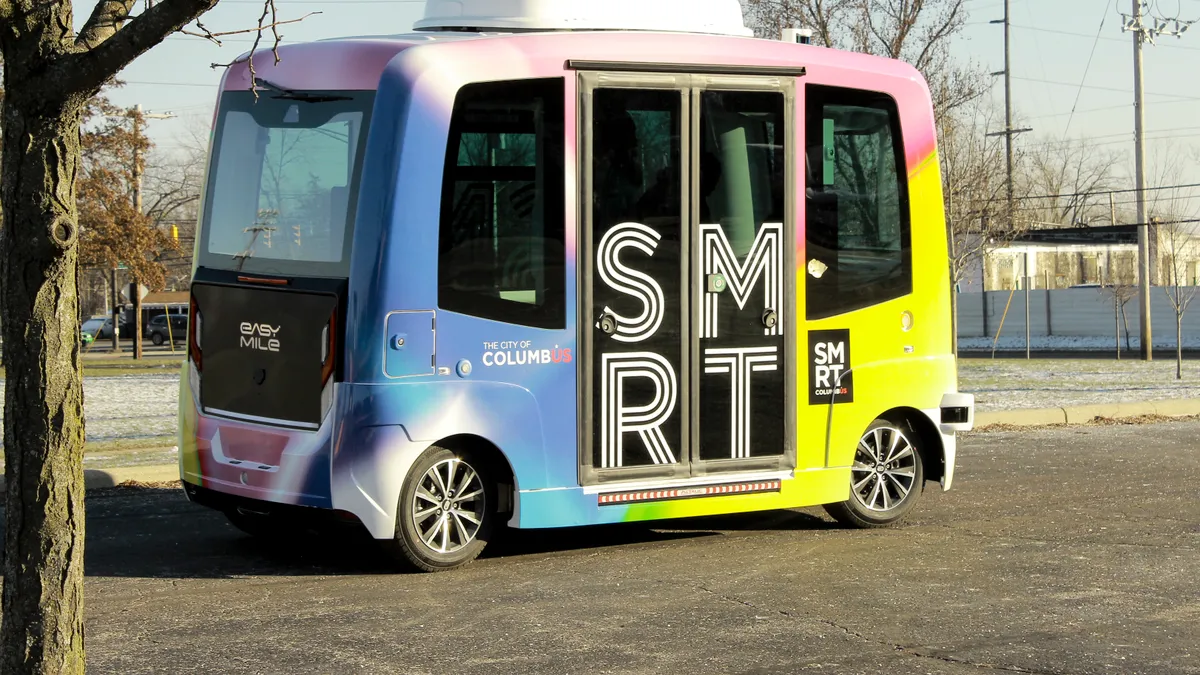Dive Brief:
-
Smart Columbus launched two self-driving electric shuttles this week in the Linden neighborhood of Columbus, OH, as part of what's said to be the country’s first self-driving shuttle service in a residential area.
-
The Linden LEAP service is a one-year pilot that will be free and open to the public. The vehicles are designed to close first mile/last mile gaps in the northeast neighborhood, which the city identifies as an opportunity zone. The shuttles connect residents to the Central Ohio Transit Authority's (COTA) CMAX line, in addition to picking up and dropping off passengers at a community recreation center, the Linden Transit Center, and other facilities that provide housing, childcare, nutrition and senior care.
-
The shuttles — named Panther and Eagle in a nod to the local mascot and a youth athletic league from 1967 — are part of the city's $50 million U.S. Department of Transportation's Smart City Challenge grant. The shuttles were funded with more than $1.1 million of that grant, Smart Columbus Program Manager Mandy Bishop told Smart Cities Dive.
Dive Insight:
Self-driving vehicles have been met with a healthy dose of skepticism from the general public, but Columbus residents are likely more familiar with the technology than most. The Linden LEAP launches on the heels of Smart Columbus and Drive Ohio's Smart Circuit self-driving shuttle service that offered free rides to the public, helping to acclimate residents with the vehicles.
Ahead of the Linden LEAP service, officials went door-to-door in the neighborhood to inform people about the service or hang flyers with information on doorknobs. Overall, people expressed excitement about the investment and asked a lot of questions about the technology, Bishop said.
Linden is a historically marginalized neighborhood, and the shuttle service aims to fill real gaps in the community. Before the service, some residents would carry their groceries about half a mile from the food pantry to the nearest bus stop, according to Bishop.
Through the pilot, the city hopes to learn how many people use the service, if the service is reliable and if the shuttles meet resident needs. Beyond serving community needs, the city also plans to learn more about the technology, including how long it takes the vehicle to charge in certain weather conditions or how often the vehicle makes unplanned stops, Bishop said.
The 12-seat shuttles will have a headway time of about 22 minutes and will include a human operator, or a "customer service ambassador." The ambassadors are employed by a local mobility startup and will ride the vehicles at all times with access to the driving controls.
The shuttles operate with a suite of sensors that "deliver a 360-degree view around the vehicle," according to a press release about the service. The sensors and software help the shuttle know where it’s located, where to steer or when to accelerate, slow down or stop.
Ultimately, COTA would like to determine how different types of technology like autonomous vehicles could fit into their fleet as a long-term solution, Bishop said.
And as more people, specifically tech workers, recognize Central Ohio and the Columbus-area as an attractive place to live, COTA and city officials will likely need to continue addressing the growing transit demand in creative, innovative ways.












